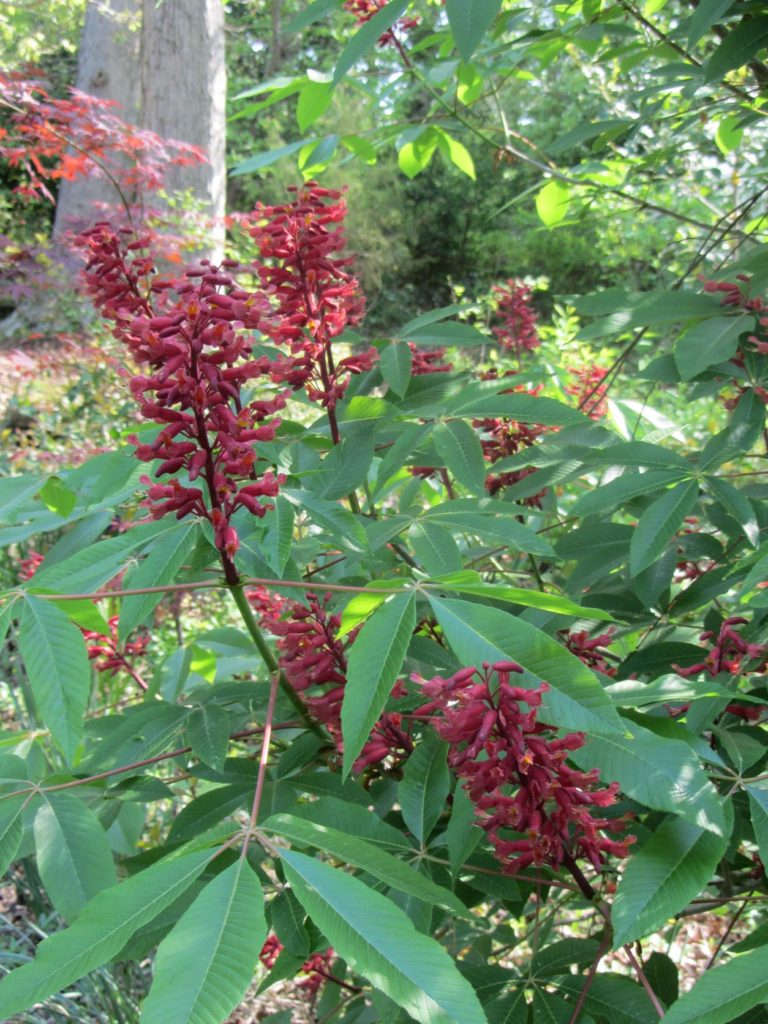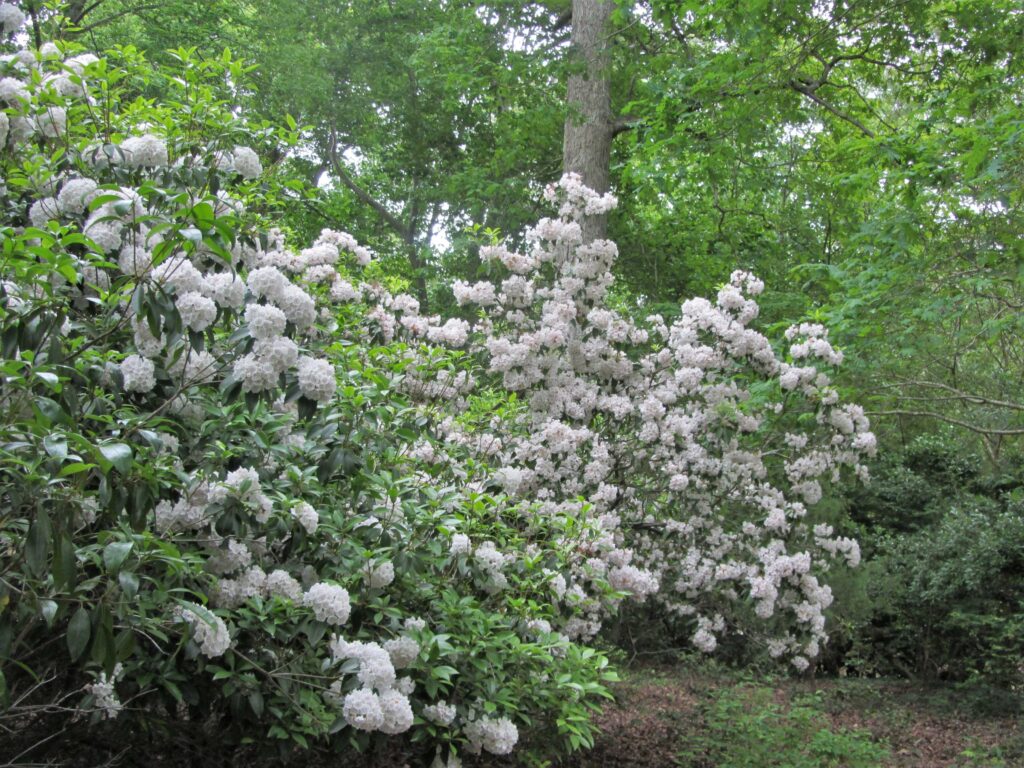Updated 2023 Plant Hardiness Map

Scarlet Buckeye blooms in April, attracting hummingbirds and other pollinators. It is indigenous to our south and has only naturalized in Virginia in recent decades.
The United States Department of Agriculture released an updated Plant Hardiness Zone map on November 15 that reflects changes for about half of the country. This updated map, the first since 2012, is based on the average coldest winter temperature, on the coldest night of the year, for each region of the country. The trend shown on this map paints an accurate picture of how many parts of our country are warming. The USDA cautions, however, that the data used to make this map, collected over the past 30 years, reflects past averages, and does not predict future weather.
Climate Zone Shift to 8A in Williamsburg and James City County
The USDA hardiness zones are based on winter cold and do not take summer heat into account. Some gardeners will be pleased that they can try new shrubs, trees, vegetables, and perennials that previously were not hardy in their area. Some ‘tender’ perennials, hardy in warmer zones but traditionally grown as annuals in our area, may now survive in the garden for a second or third season. Certain varieties of Lantana, and some species of Salvia, fall into this category. True annuals and ‘tender perennials’ like Begonias, that are hardy only to Zones 9-13, will not be affected by the change in our hardiness zone.
The Williamsburg area has shifted from Zone 7b to Zone 8a. Virginia Beach, Hampton, Portsmouth, and Norfolk, formerly in Zone 8a are now considered Zone 8b. These changes also reflect that our first frost comes later in the fall and earlier in the spring, lengthening our growing season. In Zone 8, we can expect frost to hold off until after November 15 and the last frost of spring to arrive in mid-March. While we can now try to grow new plants, previously not grown in our region, there are other plants that may no longer thrive here because they can’t stand the heat of summer or because they require a certain degree of winter cold to thrive.

Eastern red cedar, Juniperus virginiana, is hardy in Zones 2-9. It will continue to thrive in our area while other conifers need a colder climate, and will find our Williamsburg climate too warm in future years.
Implications of Too Little Winter Cold
Conifer trees and shrubs may be particularly sensitive to heat. Many popular conifers have Zone 7 as the southernmost zone where they thrive, and many beautiful trees grow only in the northern states and Canada. Changing climate in the mountains and Shenandoah Valley of Virginia may affect their Christmas Tree industry. Again, this year, we are already hearing warnings in the media about a shortage of Christmas trees.
Apple, and some other fruit trees, need a certain minimum number of ‘chilling hours’ to set a good crop of fruit the following year. In general, many species of trees and shrubs have been moving northwards and westwards over the past few centuries as the climate has warmed and precipitation patterns have shifted. In many cases the amount of annual precipitation determines which species can thrive or will die out. Erratic precipitation patterns where excessive rain and periods of drought alternate also adversely affect native vegetation, agriculture, and landscaping.
Species Creep
This general movement northwards and westwards has allowed species like Southern Magnolia, several species of oak, and Scarlet Buckeye to naturalize in our area, although it was once too cool for them to thrive here. This has serious implications for many native species that can no longer thrive in areas where they are indigenous. If the species cannot adapt and move fast enough in nature and isn’t intentionally planted in new areas where it can thrive, the population of the species will quickly decline.

Native bees love Lantana, and can be found resting on its flowers in early morning. Lantana camara, and L. montevidensis, native to states to our south, are adapting to remain perennial in Williamsburg. L. ‘Miss Huff’ and related cultivars, and L. ‘Ham and Eggs,’ now survive through Williamsburg winters, providing nectar and pollen through the autumn months. Here a bee feasts on L. ‘Ham and Eggs.’
Phenology: Nature’s Rhythm
Native plants, native insects, birds, and other animals have a fine sense of timing so that plants bloom and leaf out exactly as insects, birds, and other animals need them. Periods of dormancy tend to coincide, too. This fragile seasonal dance has been upset in recent years as the timing of emergence, migration, bloom and the length of seasons has shifted in response to weather patterns. Sometimes plants bloom either too early or too late to take advantage of traditional pollinators. Leaves may not be available when needed by insect larvae, or bees may emerge in winter when nothing native is in bloom for them forage. Non-native plants which bloom in winter can assist insects who awaken on warm winter days and need to feed. But in general, changes in an ecosystem’s phenology can create cascading problems for both animals and native plants.
Nature’s Notebook is a citizen science program to observe and document when various plants bloom, seeds ripen, insects appear, etc. in each region of the country. This tracking supports scientists in their research.

Non-native shrubs that bloom in the fall, winter, and early spring help support native insects that need forage when no native plants are blooming. Camellias and Berberis japonica provide winter nectar and pollen for native bees and other insects even though they don’t serve as larval hosts. Evergreen, they continue to absorb carbon dioxide and air pollutants during the winter months to help reduce and sequester carbon from the atmosphere.
Other Threats of a Warming Climate
New insect pests and horticultural diseases will take hold in new areas, too. Insects that once died out over winter in colder areas will now survive in greater numbers. This has implications for human health as well as for crops, parks and other natural areas, and landscaping. Since we have learned that 2023 is officially the hottest year on record since record keeping began, and that the amount of carbon dioxide in the atmosphere is at its highest level for the past 800,000 years, we should expect the warming trend to continue.
Overall, the opportunities to grow new and useful and beautiful species, particularly fruits and vegetables, may outweigh the difficulties. But the change in agricultural zones is something that all gardeners and farmers should keep in mind when planning for the season ahead and when choosing woody plants for their landscapes.

Native shrubs like Mountain laurel grows bloom several weeks earlier now than they did even ten years ago. The timing of plant and animal life cycles are changing in response to changing weather and climate patterns.
All photos by E. L. McCoy
